Reports
IAEA Iran Report: Enrichment Increases Slightly; Lack of Adequate Safeguards
by David Albright and Jacqueline Shire
Charts prepared by Christina Walrond
May 31, 2010
The International Atomic Energy Agency (IAEA) released on May 31, 2010 its latest report on the implementation of NPT safeguards in Iran and the status of Iran’s compliance with Security Council Resolutions 1737, 1747 and 1803.
The following analysis highlights the IAEA’s key findings, including 1) modestly increased production of LEU at the Natanz fuel enrichment plant; 2) expected levels of production of 20 percent LEU using a single cascade of 164 centrifuges at the pilot fuel enrichment plant (PFEP); 3) continued research and development of advanced centrifuges; and 4) no progress toward resolving outstanding questions regarding the “military applications” of Iran’s nuclear activities.
A recurring issue throughout the report concerns Iran’s minimalist application of safeguards, in particular where the IAEA seeks information about new enrichment facilities that are reportedly under construction, design information for the Fordow facility, centrifuge production, uranium mining and related activities. The IAEA continues to note that Iran’s refusal to be bound by its 2003 safeguards agreement and subsidiary arrangements does not allow the Agency to build confidence in the peaceful nature of Iran’s nuclear activities
LEU Production and centrifuge levels at Natanz Fuel Enrichment Plant
Iran’s total LEU production at the Natanz fuel enrichment plant (FEP) to date is reported to be 2,427 kg of low enriched uranium, including 362 kg estimated by Iran to have been produced from January 30, 2010 to May 1, 2010. The FEP is Iran’s primary enrichment facility where the majority of its IR-1 centrifuges are installed. Activity at the pilot fuel enrichment plant where Iran has begun to enrich uranium up to the 20 percent level, is discussed below.
The average monthly production of LEU at the FEP has increased slightly to 120 kg per month (for the last reporting period we noted it was 117 kg of LEU). Iran has introduced a total of 27,576 kg of natural uranium hexafluoride (UF6) in the centrifuges at the FEP; the average amount this reporting period is 1,307 kg per month. (See charts below). Iran is currently operating 3,936 centrifuges at the FEP; this is up slightly from the 3,772 operating over the previous reporting period. Some 4,492 centrifuges are installed but operating under vacuum (not being fed with UF6) according to this report.
Separative work output at the FEP: During this reporting period, Iran is producing at an annualized rate of about 3,560 separative work units (swu) per year, compared to an annualized separative capacity of about 3,400 swu per year in the last reporting period. Assuming all 3,936 centrifuges are enriching, each machine is achieving an average of about 0.9 swu per year. As noted in earlier ISIS reports, this average value is likely an underestimate because some of these centrifuges are not operating. The average in the last reporting period was about 0.9 swu per year per P1 centrifuge.
Activity at the Pilot Fuel Enrichment Plant
Iran has designated two cascades at the smaller, above-ground pilot fuel enrichment plant (PFEP) for the production of LEU enriched to 20 percent U235 for the Tehran Research Reactor. Only one of these cascades is being used currently for the production of this more highly enriched uranium. Between February 9 and May 21, 2010, 172 kg of low enriched uranium in the form of UF6 was introduced into the single cascade; on April 7, 2010, Iran withdrew 5.7 kg of UF6 and stored it in a small cylinder. Iran claims that the material has an enrichment of 19.7 percent U235. The second cascade would be used to further enrich the tails or waste from the first cascade.
Enhanced safeguards at the PFEP
Iran informed the IAEA in March of its plans to connect the second cascade to the first; the IAEA responded by asking Iran to wait to begin operation of the second cascade until additional safeguards could be installed at the site. The new safeguards provisions, to which Iran has agreed, include monthly inventory verification, up to two unannounced inspections per month, the placement of seals on “all possible exit routes for UF6,” and an enhanced surveillance system in the feed and withdrawal areas. These enhanced safeguards were installed in late April 2010. The Agency noted however, that the modification of the PFEP to produce 20 percent enriched uranium “was not notified to the Agency by Iran with sufficient time for the Agency to adjust its safeguards procedures” as required by Iran’s existing safeguards agreement.
Continued R&D of advanced centrifuges, but no indication of timing of deployment
Between February 3, 2010 and May 21, 2010, Iran introduced 74 kg of UF6 into a 20-machine cascade of IR-4 centrifuges, a 20-machine cascade of IR2 centrifuges and into single IR-1, IR-2 and IR-4 machines. These quantities of UF6 feed and the number of centrifuges involved indicate that this effort is still at the R&D stage.
No progress on IAEA requests for Fordow design information
According to this report, Iran continues to resist IAEA efforts to provide design information on the facility; IAEA monthly inspections confirm that construction on the facility continues. In two February letters to the IAEA responding to the Agency’s requests for design information, Iran “referred to its earlier answers on this subject and indicated that ‘the Agency is not mandated to raise any question beyond the Safeguards Agreement.”
No cooperation on centrifuge production, R&D, uranium mining and milling
The IAEA asked Iran in writing on April 23, 2010 for information related to “the manufacturing of centrifuges, R&D on uranium enrichment, and uranium mining and milling.” Iran replied only that it was “continuing to cooperate with the Agency in accordance with its Safeguards Agreement” but did not provide the requested information. This appears to be an example of Iran adhering to its 1970s-era safeguards agreement, including code 3.1 of its Subsidiary Arrangements, which does not require that such information be shared with the IAEA. The Agency notes in paragraph 30 that the Subsidiary Arrangements as agreed in 2003 “remains in force” notwithstanding Iran’s decision to suspend their implementation unilaterally.
Bushehr fuel loading set
Iran informed the IAEA that it will perform a “technical examination of the fuel assemblies” for the Bushehr reactor prior to loading them into the reactor’s core in June 2010. No specific date for the loading or official start of the reactor was provided.
Pyroprocessing R&D underway; equipment moved
Iran informed the IAEA in January 2010, during a design inspection of the Jabr Ibn Hayan Multipurpose Research Laboratory (JHL) in Tehran, that “pyroprocessing R&D activities had been initiated at JHL to study the electrochemical production of uranium metal.” Iran subsequently informed that IAEA that such work was purely research related and aimed at studying the “electrochemical behavior of uranyl ion in ionic liquid.” It is not clear in the report whether and to what extent this work is related to Iran’s weaponization research. During the IAEA’s second visit to JHL which sought to clarify the nature of the work, inspectors found that the electrochemical cell had been moved.
No progress on weaponization issues
No progress has been made on resolving what the IAEA terms “possible military dimensions” to Iran’s nuclear program. Iran continues to refuse IAEA requests to discuss such issues and insists that the documentation on which such allegations are based are forgeries. The Agency reports that it “remains concerned about the possible existence in Iran of past or current undisclosed nuclear related activities, involving military related organizations, including activities related to the development of a nuclear payload for a missile. There are indications that certain of these activities may have continued beyond 2004.”

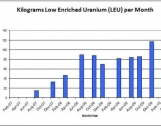
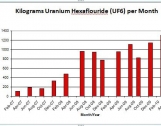
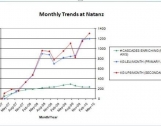
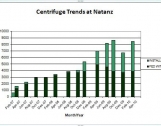
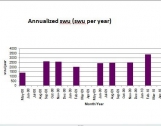
 twitter
twitter